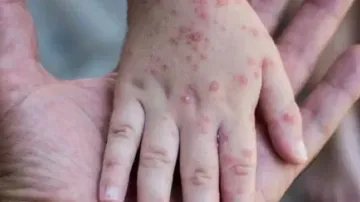Key Facts
There is no treatment or vaccine available to combat the disease, although the previous vaccination against smallpox has proven highly effective in preventing monkeypox as well.
Monkeypox virus is transmitted to humans by a variety of wild animals, but its secondary spread is limited by human-to-human transmission.
Monkeypox is a rare disease that occurs primarily in remote western areas of central and Africa near tropical rainforests.
Monkeypox is a rare and zoonotic viral disease (the virus is transmitted from animals to humans) and the symptoms of human infection are similar to those seen in the past in patients with smallpox, but it is less severe. Although smallpox was eradicated in 1980, monkeypox still occurs sporadically in some parts of Africa.
The monkeypox virus belongs to the genus Orthopoxvirus of the family Poxviruses.
This virus was first detected in 1985 at the State Institute of Serology in Copenhagen, Denmark, while investigating a smallpox-like disease among monkeys.
disease outbreaks
Monkeypox was first in humans in 1970 in the Democratic Republic of the Congo (then known as Zaire) in a 9-year-old boy who lived in an area where smallpox was eradicated in 1968. Most cases have since been reported in rural areas of the country. The rainforests of the Congo Basin and West Africa, particularly in the Democratic Republic of the Congo, where it was thought to be endemic, where a major outbreak of the disease occurred in 1996 and 1997.
In the fall of 2003, confirmed cases of monkeypox were reported in the western central region of the United States of America, indicating that it was the first reported case of the disease outside the African continent, and it was found that most of the infected patients with it had had close contact with prairie dogs. .
In 2005, an outbreak of monkeypox occurred in Unity State, Sudan, and sporadic cases were reported in other parts of Africa. In 2009, an awareness campaign among refugees from the Democratic Republic of the Congo to the Republic of the Congo identified and confirmed two cases of monkeypox, while 26 cases and two deaths were contained in another outbreak of the disease in the Central African Republic between August and October. October 2016.
disease transmission
Infection with the disease results from indicative cases of direct contact with the blood of infected animals, their body fluids, their skin lesions, or their mucous fluids. In Africa, it has been documented cases of infection caused by handling monkeys, giant Gambian rats or squirrels infected with the disease, bearing in mind that rodents are the main reservoir of the virus. . It is possible that eating undercooked meat from infected animals is a risk factor associated with the disease.
Transmission of the disease at the secondary level or from person to person can result from intimate contact with the respiratory tract secretions of an infected person or its skin lesions, or from contact with objects that have recently been contaminated with the patient's fluids or pest-causing substances. The disease is primarily transmitted through respiratory particles in the form of droplets that usually require long periods of face-to-face contact, exposing family members of active cases to a high risk of infection. The disease can also be transmitted through vaccination or through the placenta (congenital monkeypox), and there is still no evidence that monkeypox can persist in human beings simply by transmission from one person to another.
Recent animal studies in the study of the model of transmission of monkeypox from prairie dogs to humans identified two different phases of viruses - the Congo Basin virus and West African phase - with the first phase being more virulent.
Disease signs and symptoms
The incubation period for monkeypox (the period between infection and symptoms) ranges from 6 to 16 days, but can range from 5 to 21 days.
The infection stage can be divided into two periods as follows:
Invasive period (0 days and 5 days), characterized by fever, severe headache, enlarged lymph nodes, back and muscle pain, and severe weakness (loss of energy);
The rash period (within 1 to 3 days after a fever) in which the various stages of the rash appear, starting most often on the face and then spreading to other parts of the body. The rash is most severe on the face (in 95% of cases) and on the palms of the hands and soles of the feet (75%). In about 10 days, the rash develops from macular papules (flat-based lesions) to vesicles (small fluid-filled blisters) and pustules, followed by crusts that may take up to three weeks to disappear completely.
The number of lesions ranges from a few to several thousand, and they affect the mucous

membrans of the mouth (in 70% of cases), the genitals (30%) and the conjunctiva of the eye (20%), as well as its cornea (eyeball).
Some patients develop severe swollen lymph nodes before the rash appears, a feature that distinguishes mon
